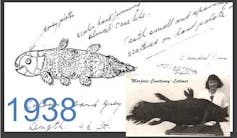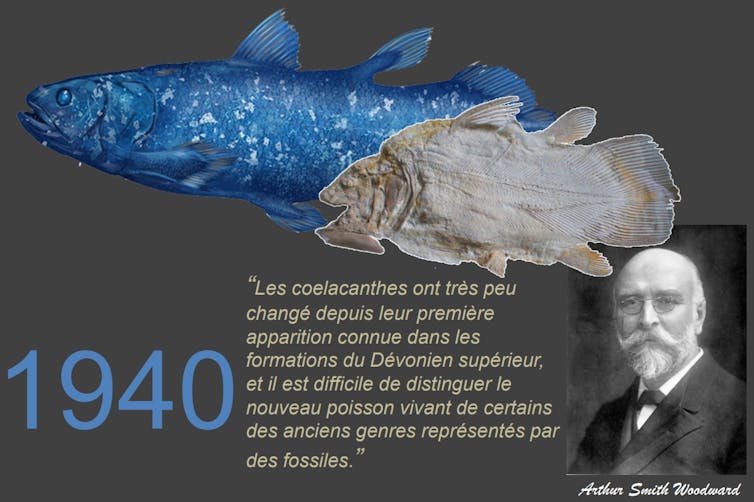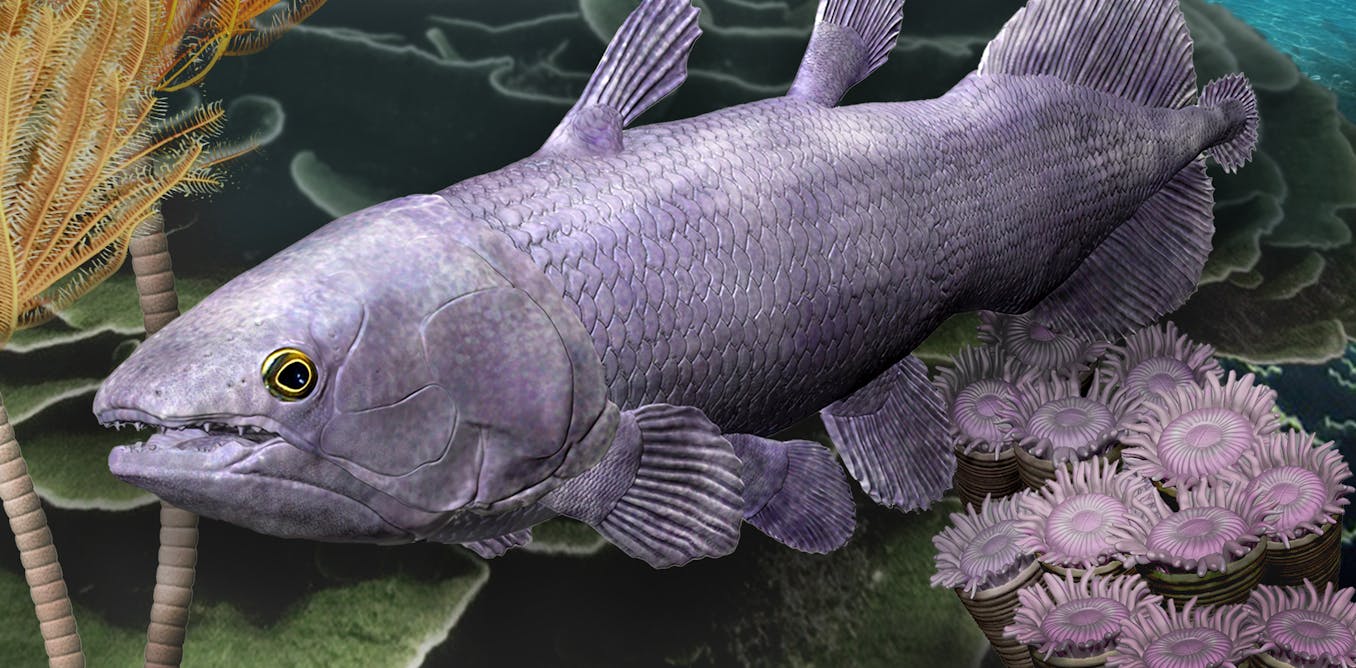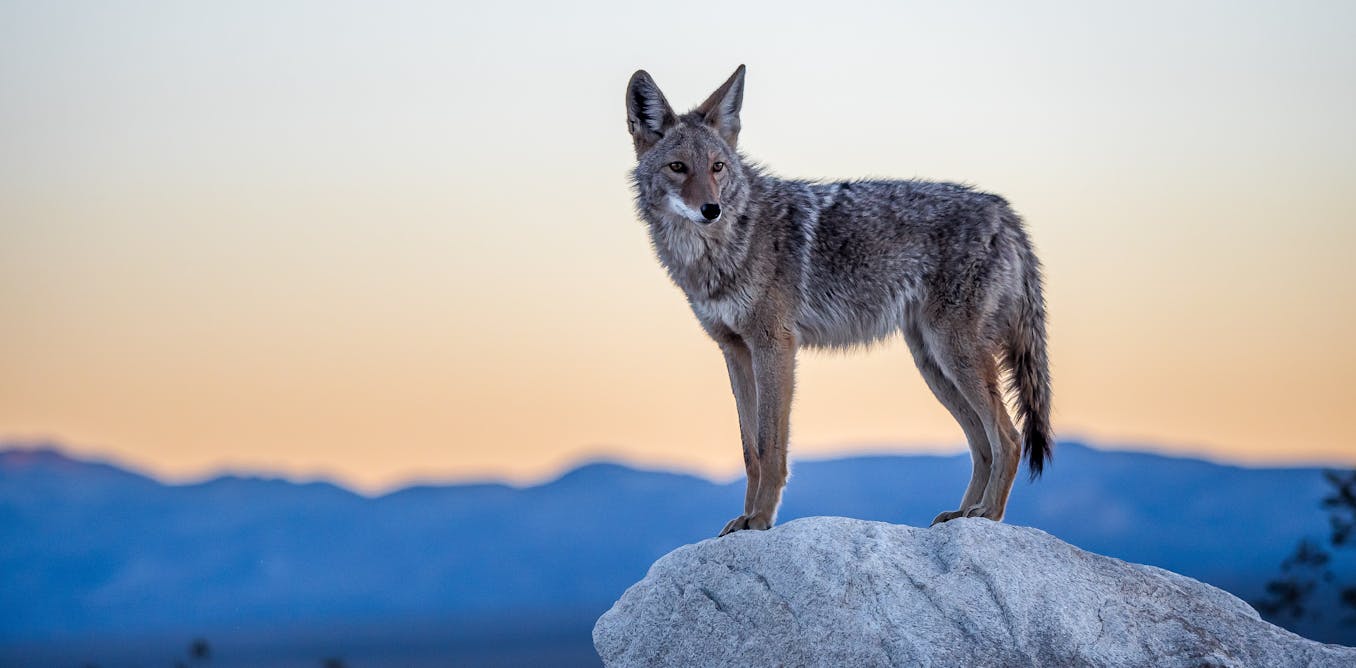What do the ginkgo (a tree), the nautilus (a mollusc) and the coelacanth (a fish) all have in common?
They don’t look alike, and they aren’t biologically related, but part of their evolutionary history bears a striking resemblance: these organisms are referred to as “living fossils”. In other words, they appear to have escaped the transformations that normally come about over time, through evolution.
For the past 85 years, the coelacanth has been dubbed a “living fossil” because it evokes a bygone era, the age of dinosaurs. These fish belong to the sarcopterygians, a group that also includes lungfish (fish with lungs) and tetrapods, a group to which humans also belong. Tetrapods are vertebrates (animals with a backbone) that share specific anatomical features, including the presence of a humerus (forelimb bones), a femur (hindlimb bones) and lungs.
Few vertebrate species spark as much curiosity as the coelacanth, as much for the fascinating story of its discovery as for its status as a “living fossil.” What’s more, the only two living species of coelacanth, survivors of this long evolutionary process, are now threatened with extinction.
But does the coelacanth really deserve this label? And what do coelacanth fossils tell us about this evolutionary curiosity?
Respectively a paleontologist, evolutionary biologist and ecological modeller, we are taking a fresh look at the 410 million-year evolutionary history of coelacanths in this article. Using the latest technological advances and innovative analysis methods available, we are working to better understand the evolution of these fascinating species, often referred to as “living fossils”.
A major discovery in Western Australia
Our research, recently published in the journal Nature Communications, identifies and describes the fossils of a 380-million-year-old extinct species of coelacanth that was discovered in Western Australia.
These remarkably well-preserved fossils come from a key transitional period in the long evolutionary history of this fish species.
This study is the result of an international collaboration between researchers affiliated with institutions in Canada, Australia, Germany, the UK and Thailand.
“Living fossils”: A concept under debate
Charles Darwin was the first to use the expression “living fossil” in his book The Origin of Species, in 1859, to designate living species he considered “aberrant” or “abnormal” with respect to others at the time.
Although the concept was not clearly defined at Darwin’s time, it has been taken up by hundreds of biologists since then. However, the term “living fossil” and the species that deserve the title, remains a subject of debate in the scientific community.
In general, for a taxon (a scientifically classified group or entity) to be considered a “living fossil,” it must meet certain criteria: it must belong to a group that has existed for millions of years, have changed little morphologically over time, and present so-called primitive characteristics compared to its close evolutionary relatives.
A fascinating history: Coelacanths through the ages
More than 175 species of fossil coelacanth lived between the Lower Devonian period (419 to 411 million years ago) and the end of the Cretaceous period (66 million years ago). In 1844, Swiss paleontologist Louis Agassiz identified a particular group of fossil fish, which he named the order of coelacanths.
For almost a century, coelacanths were thought to have become extinct at the end of the Cretaceous period, around 66 million years ago. During this time nearly 75 per cent of life on Earth became extinct, including the majority of dinosaurs — with the exception of the ancestor of birds.

Then, on Dec. 22, 1938, Marjorie Courtenay-Latimer, the curator of the East London Museum in South Africa, received a call from a fisherman who had caught a rare and strange fish. She realized it was an unknown species and contacted South African ichthyologist (fish biologist) J.L.B. Smith, who confirmed that it was, in fact, the first living coelacanth ever observed.

In 1939, Smith named the species Latimeria chalumnae, also known as gombessa. Since then, this species, found along the east coast of Africa near the Comoros Archipelago, in the Strait of Mozambique, and off the coast of South Africa, has attracted considerable scientific interest.
In 1998, a second living species of coelacanth, Latimeria menadoensis (named ikan raja laut, the king fish of the sea, in Indonesian), was discovered off the island of Sulawesi, in Indonesia.
These two species are the only survivors of an ancient lineage that appears to have evolved little over the last few million years.
Following the discovery of Latimeria chalumnae, coelacanths were considered vertebrates whose body shape has changed little over time, suggesting slow evolution.

Ngamugawi or “ancient fish”
In our study, we describe a new species of coelacanth from the Devonian period of Western Australia. We have named it Ngamugawi wirngarri. Ngamugawi means “ancient fish” in Gooniyandi, the language of the Australian aboriginal people of the Kimberley region. Wirngarri pays homage to Wirngarri, a respected ancestor of the Gooniyandi.
Ngamugawi wirngarri was discovered in the Gogo geological formation, world-renowned as an exceptional fossil site. Gogo is famous for the three-dimensional preservation of numerous fish fossils, and sometimes even soft tissues such as the heart and muscles.
To date, over 50 species of fossil fish have been identified at Gogo. This diverse group of fish, coupled with that of marine invertebrates, cohabited in a Devonian warm sea coral reef around 380 million years ago.

A more complex evolution than it seems
Our study reveals that coelacanths evolved rapidly at the beginning of their history, during the Devonian period, but that this evolution slowed down after that. Evolutionary innovations almost ceased after the Cretaceous period, suggesting that for some traits, coelacanths, like Latimeria, appear to be frozen in time.
However, other features, such as body proportions, continued to evolve at a normal rate during the Mesozoic period (252 to 66 million years ago). Although body shape changed little, supporting the idea that Latimeria is a “living fossil,” the evolution of cranial bone shape never ceased, which calls the label into question.
Of all the environmental variables studied, tectonic plate activity has the most marked influence on coelacanth evolutionary rates. New coelacanth species were more likely to emerge during periods of intense tectonic activity when new habitats were created or fragmented.
The Ngamugawi discovery shows that coelacanths have not remained unchanged for millions of years.
Their slow evolution shows that they are not “living fossils,” but, in fact, the result of a complex evolutionary history.

The post “We discovered a new fossil species of prehistoric fish” by Richard Cloutier, Professor of Evolutionary Biology, Université du Québec à Rimouski (UQAR) was published on 10/23/2024 by theconversation.com





































Leave a Reply